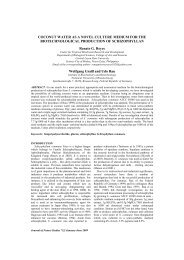Downstream processing of mannosylerythritol lipids produced by ...
Downstream processing of mannosylerythritol lipids produced by ...
Downstream processing of mannosylerythritol lipids produced by ...
Create successful ePaper yourself
Turn your PDF publications into a flip-book with our unique Google optimized e-Paper software.
Eur. J. Lipid Sci. Technol. 107 (2005) 373–380 <strong>Downstream</strong> MEL 379<br />
Tab. 1. Comparison <strong>of</strong> different methods for the downstream<br />
<strong>processing</strong> <strong>of</strong> MEL { .<br />
Ref. Method § Yield<br />
[wt-%]<br />
# Purity<br />
[wt-%]<br />
[22] Ethyl acetate extraction 1<br />
preparative HPLC<br />
79 100<br />
[15] Ethyl acetate extraction 1<br />
preparative HPLC<br />
4 100<br />
Stepwise extraction with<br />
different solvents (Fig. 3)<br />
8 100<br />
Heat treatment (Fig. 4) 93 87<br />
{ Preparative HPLC was performed with silica gel columns.<br />
§ g MEL recovered<br />
Yield =<br />
g MEL before downstream 100<br />
#<br />
Purity is related to the mass fraction <strong>of</strong> MEL.<br />
in the precipitated fraction. However, this solid-enriched<br />
MEL phase should be pure enough for the most industrial<br />
applications [5–8]. For example, pure MEL A, purified<br />
100% (wt-%) MEL and a mixture <strong>of</strong> 88.3% MEL, 6.6%<br />
soybean oil and 5.1% (wt-%) fatty acids reduced the surface<br />
tension <strong>of</strong> water/air to similar data <strong>of</strong> 34.7, 26.7 and<br />
31 mN m 21 , respectively [17].<br />
5 Conclusion<br />
Bioreactor production <strong>of</strong> <strong>mannosylerythritol</strong> <strong>lipids</strong> was<br />
performed <strong>by</strong> the use <strong>of</strong> Pseudozyma aphidis<br />
DSM 14930. Up to 93% (wt-%) MEL could be transferred<br />
into a solid, highly viscous phase <strong>by</strong> heating the culture<br />
suspension to 110 7C for 10 min. This phase contained on<br />
average 87% (wt-%) MEL and could be simply isolated <strong>by</strong><br />
pouring <strong>of</strong>f the supernatant, without producing solvent<br />
waste. Together with the high MEL yield <strong>of</strong> 165 g L 21 ,<br />
obtained <strong>by</strong> foam-controlled addition <strong>of</strong> soybean oil [18],<br />
this facilitated downstream process should stimulate the<br />
industrial production <strong>of</strong> MEL.<br />
Acknowledgments<br />
We thank W. Grassl for technical assistance.<br />
References<br />
[1] G. Georgiou, S. C. Lin, M. Sharma: Surface-active compounds<br />
from microorganisms. Biotechnology 1992, 10,60–65.<br />
[2] D. Kitamoto, H. Isoda, T. Nakahara: Functions and potential<br />
applications <strong>of</strong> glycolipid biosurfactants – from energy-saving<br />
materials to gene delivery carriers. J Biosci Bioeng. 2002, 94,<br />
187–201.<br />
[3] M. Shibahara, X. Zhao, Y. Wakamatsu, N. Nomura, T. Nakahara,<br />
C. Jin, H. Nagaso, T. Murata, K. K. Yokoyama: Mannosylerythritol<br />
lipid increases levels <strong>of</strong> galactoceramide in<br />
and neurite outgrowth from PC12 pheochromocytoma cells.<br />
Cytotechnol. 2000, 33, 247–251.<br />
[4] L. Vertesy, M. Kurz, J. Wink, G. Noelken: Patent US<br />
6,472,158 (2002).<br />
[5] J. H. Im, H. Yanagishita, T. Ikegami, Y. Takeyama, Y. Idemoto,<br />
N. Koura, D. Kitamoto: Mannosylerythritol <strong>lipids</strong>,<br />
yeast glycolipid biosurfactants, are potential affinity ligand<br />
materials for human immunoglobulin G. J Biomed Mater<br />
Res. 2003, 65A, 379–385.<br />
[6] D. Kitamoto, H. Yanagishita, A. Endo, M. Nakaiwa, M.<br />
Nakane, T. Akiya: Remarkable antiagglomeration effect <strong>of</strong> a<br />
yeast biosurfactant, diacyl<strong>mannosylerythritol</strong>, on ice-water<br />
slurry for cold thermal storage. Biotechnol Progress 2001,<br />
17, 362–365.<br />
[7] Z. Hua, J. Chena, S. Luna, X. Wang: Influence <strong>of</strong> biosurfactants<br />
<strong>produced</strong> <strong>by</strong> Candida antarctica on surface properties<br />
<strong>of</strong> microorganism and biodegradation <strong>of</strong> n-alkanes. Water<br />
Research 2003, 37, 4143–4150.<br />
[8] Z. Hua, Y. Chen, G. Du, J. Chen: Effects <strong>of</strong> biosurfactants<br />
<strong>produced</strong> <strong>by</strong> Candida antarctica on the biodegradation <strong>of</strong><br />
petroleum compounds. World J Microbiol Biotechnol. 2004,<br />
20, 25–29.<br />
[9] D. Kitamoto, S. Akiba, C. Hioki, T. Tabuchi: Extracellular<br />
accumulation <strong>of</strong> <strong>mannosylerythritol</strong> <strong>lipids</strong> <strong>by</strong> a strain <strong>of</strong><br />
Candida antarctica. Agric Biol Chem. 1990, 54, 31–36.<br />
[10] S. Spoeckner, V. Wray, M. Nimtz, S. Lang: Glyco<strong>lipids</strong> <strong>of</strong> the<br />
smut fungus Ustilago maydis from cultivation on renewable<br />
resources. Appl Microbiol Biotechnol. 1999, 51, 33–39.<br />
[11] G. Deml, T. Anke, F. Oberwinkler, B. M. Gianetti, W. Steglich:<br />
Schizonellin A and B, new glyco<strong>lipids</strong> from Schizonella melanogramma.<br />
Phytochem. 1980, 19, 83–87.<br />
[12] K. Kakugawa, M. Tamai, K. Imamura, K. Miyamoto, S.<br />
Miyoshi, Y. Morinaga, O. Suzuki, T. Miyakawa: Isolation <strong>of</strong><br />
yeast Kurtzmanomyces sp. I-11, novel producer for <strong>mannosylerythritol</strong><br />
lipid. Biosci Biotech Biochem. 2002, 62, 188–<br />
191.<br />
[13] H. Kawashima, T. Nakahara, M. Oogaki, T. Tabuchi: Extracellular<br />
production <strong>of</strong> a <strong>mannosylerythritol</strong>lipid <strong>by</strong> a mutant<br />
<strong>of</strong> Candida sp. from n-alkanes and triacylglycerols. J Ferment<br />
Technol. 1983, 61, 143–149.<br />
[14] D. Kitamoto, T. Yokoshima, H. Yanagishita, K. Haraya, H. K.<br />
Kitamoto: Formation <strong>of</strong> glycolipid biosurfactant, <strong>mannosylerythritol</strong><br />
lipid, <strong>by</strong> Candida antarctica from aliphatic hydrocarbons<br />
via subterminal oxidation pathway. J Jpn Oil Chem<br />
Soc. 1999, 48, 1377–1384.<br />
[15] H.-S. Kim, B. D. Yoon, D. H. Choung, H.-M. Oh, T. Katsuragi,<br />
Y. Tani: Characterization <strong>of</strong> a biosurfactant, MEL, <strong>produced</strong><br />
from Candida sp. SY16. Appl Microbiol Biotechnol. 1999,<br />
52, 713–721.<br />
[16] M. Adamczak, W. Bednarski: Influence <strong>of</strong> medium composition<br />
and aeration on the synthesis <strong>of</strong> biosurfactant <strong>produced</strong><br />
<strong>by</strong> Candida antarctica. Biotechnol Lett. 2000, 22,<br />
313–316.<br />
[17] U. Rau, L. A. Nguyen, S. Schulz, V. Wray, M. Nimtz, H. Roeper,<br />
H. Koch, S. Lang: Formation and analysis <strong>of</strong> <strong>mannosylerythritol</strong><br />
<strong>lipids</strong> secreted <strong>by</strong> Pseudozyma aphidis. Appl<br />
Microbiol Biotechnol. 2005, 66, 551–559.<br />
[18] U. Rau, L. A. Nguyen, H. Roeper, H. Koch, S. Lang: Fedbatch<br />
bioreactor production <strong>of</strong> <strong>mannosylerythritol</strong> <strong>lipids</strong><br />
secreted <strong>by</strong> Pseudozyma aphidis. Appl Microbiol Biotechnol.<br />
2005, DOI 10.1007/s00253-005-1906-5.<br />
© 2005 WILEY-VCH Verlag GmbH & Co. KGaA, Weinheim www.ejlst.de



